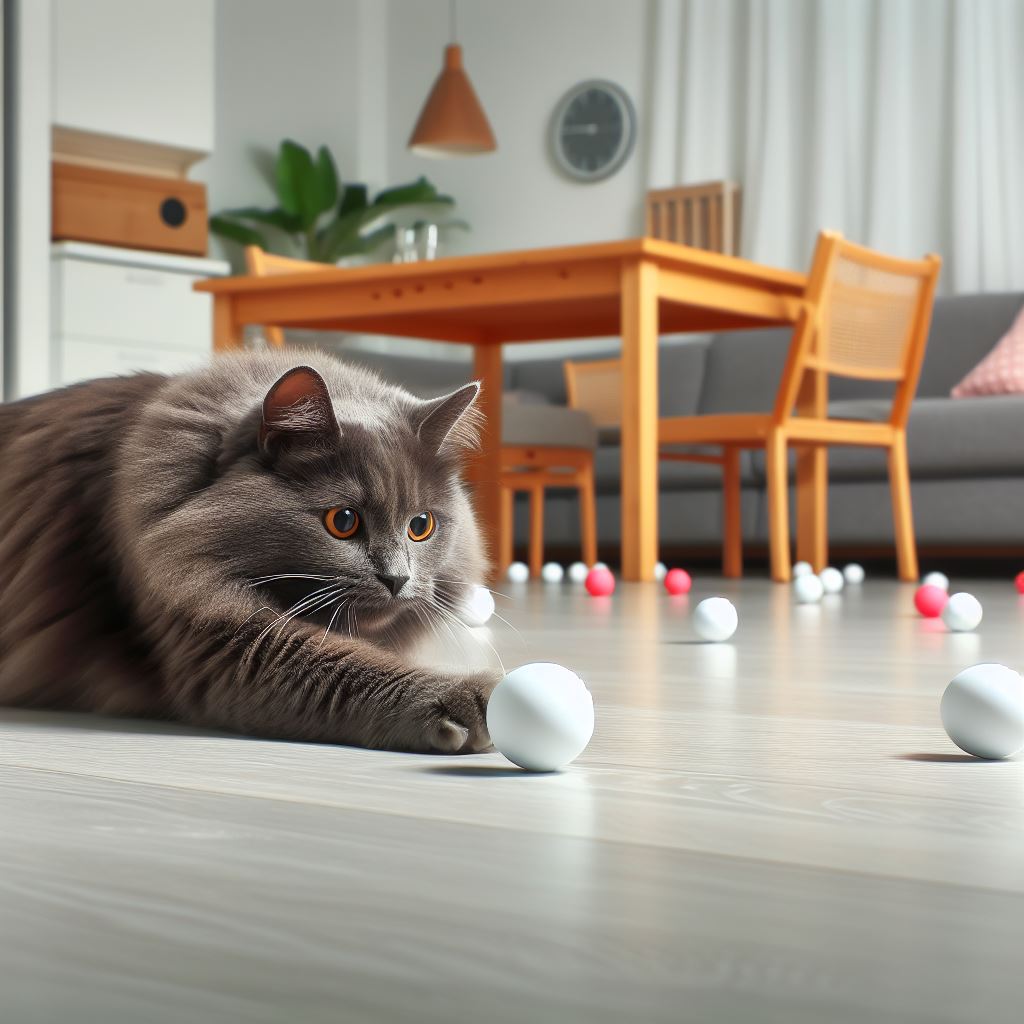Cats are often seen as independent and aloof pets who like to do their own thing. So you may be surprised to find your cat eagerly chasing after toys you throw or batting small objects back to you. While cats generally don’t naturally play fetch like dogs do, some cats can in fact be trained to fetch.
Whether you want to play a fun game with your cat or are just curious about their behavior, understanding your cat’s natural instincts provides insight into why some cats play fetch while others don’t. Let’s take a closer look at why cats play fetch, which cats are more likely to fetch, tips for training your cat to fetch, and other interactive games to try.
Why Do Some Cats Play Fetch?
Fetching behavior in cats stems from their natural hunting instincts. In the wild, cats are solitary hunters who catch small prey like mice or birds. They have a strong prey drive and love to chase moving objects.
When you throw a toy for your cat, their instincts tell them to hunt down, capture, and return their “prey” back to you. This mimics their natural behavior of bringing dead prey back home.
So cats that play fetch are essentially viewing you as their human companion and the throw toy as their pretend prey. It satisfies their primal need to hunt, while also being a bonding activity with you.
Which Cats Are More Likely To Fetch?
Whether a cat will fetch depends a lot on their personality and breed traits.
In general, energetic and playful cats are much more likely to fetch than lazy or reserved cats. Kittens and younger cats tend to be more inclined to play fetch than older cats who calm down with age.
Certain breeds like Abyssinians, Bengals, Bombays, Maine Coons, Savannahs, and Siamese are especially smart, active, and social. They often take more naturally to playing fetch compared to aloof breeds like Persians or Russian Blues.
But any breed or mix can fetch if properly trained and motivated with rewards! The key is tapping into their natural prey-drive instincts.
Tips For Training Your Cat To Fetch

Playing fetch is a great way to provide your cat with exercise and mental stimulation. Here are some handy tips for training even resistant cats to fetch:
1. Use Irresistible Toys That Trigger Their Prey Drive
Cats are more motivated to chase and return toys that appeal to their hunting instincts, like:
- Feather wands or artificial fur mice that mimic birds or rodents. The movement stimulates their interest.
- Balls, plastic eggs, or scrunched paper that can be batted around. The erratic motion when thrown triggers the cat’s prey drive.
- Catnip toys make even lazier cats get active and silly. The herb smells similar to cat pheromones.
2. Try Different Toys Until You Find Their Favorite
Every cat’s personality and preferences differ. Experiment with different types of fetch toys to discover which ones excite your cat the most. Observe their reactions to determine their favorites.
The most enticing fetch toys are usually lightweight, easy to grasp, and make unpredictable movements. But be open to surprises in what sparks your cat’s interest.
3. Start Slow With Short Distances
When first training your cat to fetch, only throw toys a short distance away, like 2-3 feet. This prevents them from losing interest and builds confidence.
Use an excited tone and keep fetch sessions brief at first, no longer than 10-15 minutes. Short, positive training periods will motivate your cat to run after and return the toys.
As your cat learns the game, gradually increase the distance and time spent playing fetch. But end the session while they still seem interested to avoid boredom.
4. Reward With Treats and Praise
Just like any training, give your cat lots of positive reinforcement and rewards when they successfully return the toy. Praise them enthusiastically, pet them, and give them treats they love like freeze-dried meat or Greenies.
This positive association will encourage the desired fetching behavior. Use food rewards intermittently once your cat understands the game.
5. Consider Clickers For Additional Training
Clicker training can be very effective when teaching a cat to fetch. The sharp sound marks the exact moment your cat does the desired behavior.
To implement:
- First charge the clicker by clicking and immediately treating your cat until they connect the sound with a reward.
- Next, click the moment your cat touches, chases after, or returns the toy. Reward with a treat.
- Keep repeating this sequence until your cat learns that fetching the toy earns a click and treat. It becomes a fun game for them!
6. Practice Fetch Daily For Best Results
Like most training, daily short practice sessions work better than long infrequent ones. Aim for two 5-10 minute fetch games per day to reinforce the learning.
Be patient, as some cats may take weeks before successfully fetching toys back to you. Your cat may seem to lose interest for a while, but keep trying and use high-value rewards. With time, they can learn to love playing fetch.
Other Fun Interactive Games To Play With Your Cat
If your cat ends up not taking to fetching, don’t worry! There are many other great interactive games to provide exercise and bonding time with your kitty:
- Chase a laser pointer dot around the room. Move it up walls and just out of reach to stimulate their prey drive.
- Use puzzle feeders or toy balls that dispense treats as they bat the toy around. It satisfies their curiosity and hunting skills.
- Tie toys onto a stick to create a customizable teaser wand for them to stalk and chase. Drag it along the floor just ahead of their grasp.
- Hide treats or catnip around the house and encourage them to hunt for the goodies. Make it easier at first.
- Set up a cat obstacle course using tubes, tunnels, ramps, cardboard boxes, and paper bags. Change up the configuration to keep it interesting.
- Toss ping pong balls into an empty bathtub or cardboard box so they bounce around erratically for your cat to chase.
The key is engaging their natural instincts to stalk, chase, and pounce. Rotate a variety of interactive toys to prevent boredom. And be sure to play with your cat yourself – they love your attention and involvement!
Frequently Asked Questions About Cats Playing Fetch
Here are answers to some common questions for cat owners wondering about their cat’s fetching behavior:
Why does my cat fetch sometimes but ignore toys other times?
Cats like fetching on their own terms! If they don’t feel like playing at the moment or are distracted, they probably won’t be receptive. Make sure to play when your cat seems energetic and attentive. Hunger and mood greatly impact their interest in fetch.
Why does my cat “kill” the toy after fetching it?
It’s just your cat’s natural hunting sequence in action. After catching their “prey,” they will pretend to kill it by biting or bunny-kicking the toy. Allow your cat to do this before throwing it again as it satisfies their instincts.
Why does my cat lose interest in the toy after a few fetches?
Cats generally have short attention spans, especially for repetitive activities. Keep fetch sessions brief and be sure to change up the toys. Try wand toys, catnip kickers, and treat balls to rekindle their enthusiasm. End on a positive note rather than dragging out playtime.
How do I stop my cat from eating or destroying fetch toys?
Redirect their biting or chewing into more appropriate toys they can freely destroy. Provide a designated cat scratcher, cardboard boxes, or plastic chain links to satisfy their need to chew and shred. Avoid yarn, rubber bands, and choking hazards.
Why does my cat bring me toys when I’m not playing fetch?
If your cat starts bringing you unsolicited “gifts,” that means they consider you part of their family! It’s a natural instinct to share prey with loved ones. Praise them when they do this and indulge them with a short play session as a reward.
So while cats may not play fetch exactly like dogs, many intelligent and active cats certainly have the capability. With the right motivation and training techniques, you can potentially teach even the most stubborn feline to fetch.
Remember to keep expectations realistic – some cats may only reliably fetch specific toys or fetch sporadically. But incorporating fetch and other interactive play provides great mental stimulation and exercise for your pet. A regular play routine strengthens the bond with your cat, keeping them active and engaged.
In Conclusion:
- Cats can play fetch thanks to their natural hunting instincts, though some cats are more prone to fetching based on breed, personality, and energy levels.
- Use interactive toys that appeal to your cat’s prey drive and food motivation to train them to run after and return toys.
- Practice fetch in short, rewarding training sessions. Praise and treat your cat when they successfully retrieve toys.
- Try other fun interactive games like laser pointers, treat balls, obstacle courses, and hide-and-seek if your cat doesn’t take to fetching.
- A regular play routine provides your cat important mental stimulation, exercise, and quality bonding time with you. Understanding their behavior and instincts allows you to have more fulfilling playtime.
So embrace your cat’s inner hunter and make playtime an enriching part of their daily routine! With some creativity and patience, you can engage even aloof cats in games that stimulate their natural instincts.




